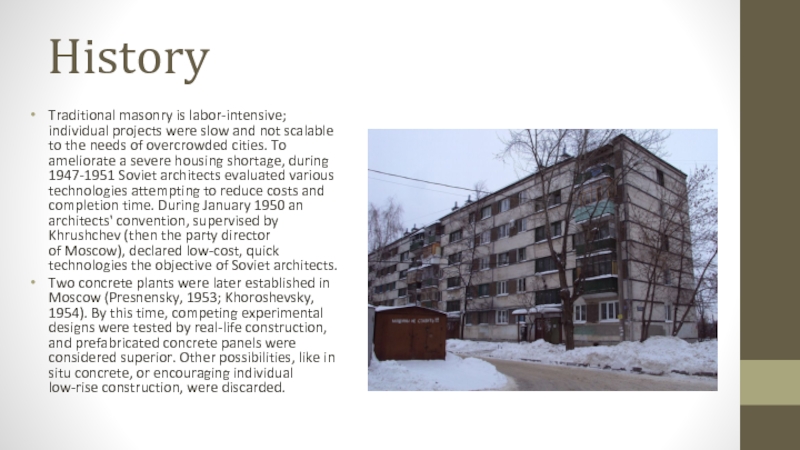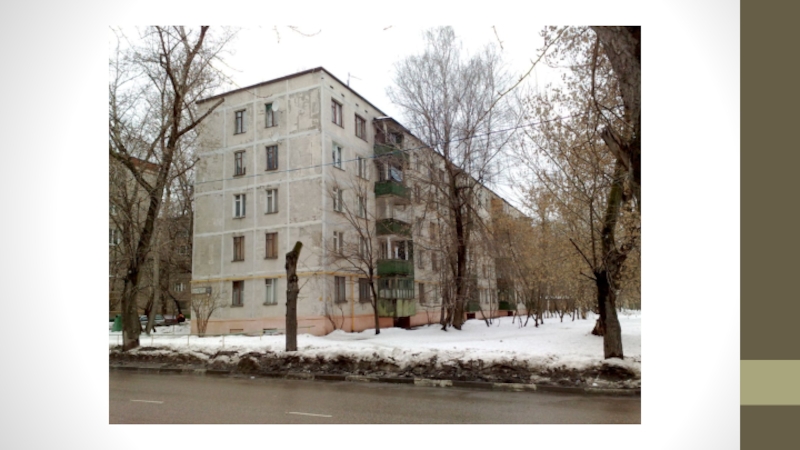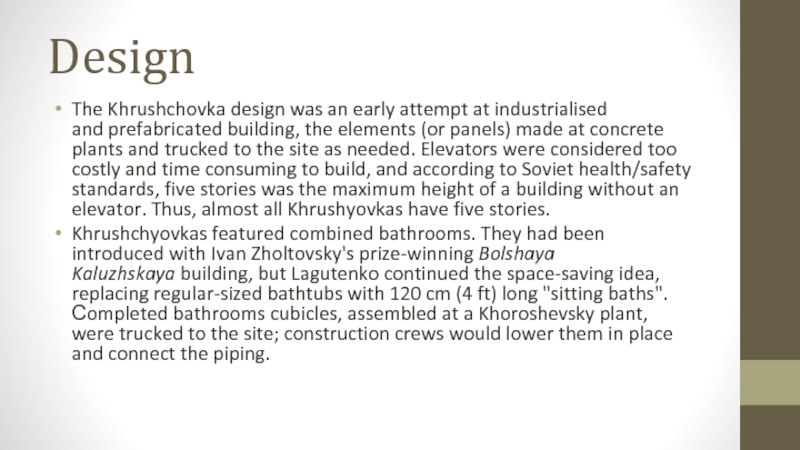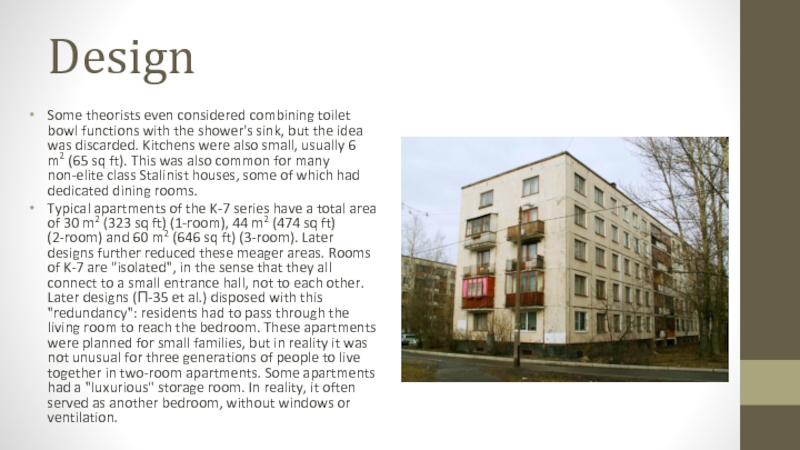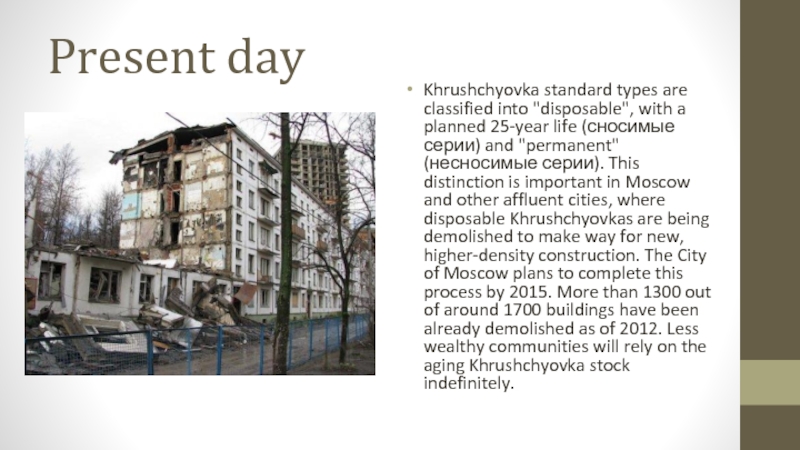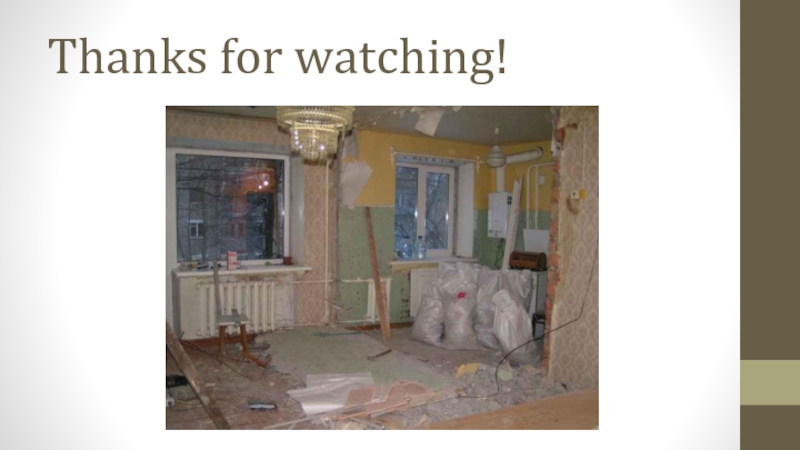- Главная
- Разное
- Дизайн
- Бизнес и предпринимательство
- Аналитика
- Образование
- Развлечения
- Красота и здоровье
- Финансы
- Государство
- Путешествия
- Спорт
- Недвижимость
- Армия
- Графика
- Культурология
- Еда и кулинария
- Лингвистика
- Английский язык
- Астрономия
- Алгебра
- Биология
- География
- Детские презентации
- Информатика
- История
- Литература
- Маркетинг
- Математика
- Медицина
- Менеджмент
- Музыка
- МХК
- Немецкий язык
- ОБЖ
- Обществознание
- Окружающий мир
- Педагогика
- Русский язык
- Технология
- Физика
- Философия
- Химия
- Шаблоны, картинки для презентаций
- Экология
- Экономика
- Юриспруденция
Khrushchyovka презентация
Содержание
Слайд 2History
Traditional masonry is labor-intensive; individual projects were slow and not scalable to the
needs of overcrowded cities. To ameliorate a severe housing shortage, during 1947-1951 Soviet architects evaluated various technologies attempting to reduce costs and completion time. During January 1950 an architects' convention, supervised by Khrushchev (then the party director of Moscow), declared low-cost, quick technologies the objective of Soviet architects.
Two concrete plants were later established in Moscow (Presnensky, 1953; Khoroshevsky, 1954). By this time, competing experimental designs were tested by real-life construction, and prefabricated concrete panels were considered superior. Other possibilities, like in situ concrete, or encouraging individual low-rise construction, were discarded.
Two concrete plants were later established in Moscow (Presnensky, 1953; Khoroshevsky, 1954). By this time, competing experimental designs were tested by real-life construction, and prefabricated concrete panels were considered superior. Other possibilities, like in situ concrete, or encouraging individual low-rise construction, were discarded.
Слайд 4Design
The Khrushchovka design was an early attempt at industrialised and prefabricated building, the
elements (or panels) made at concrete plants and trucked to the site as needed. Elevators were considered too costly and time consuming to build, and according to Soviet health/safety standards, five stories was the maximum height of a building without an elevator. Thus, almost all Khrushyovkas have five stories.
Khrushchyovkas featured combined bathrooms. They had been introduced with Ivan Zholtovsky's prize-winning Bolshaya Kaluzhskaya building, but Lagutenko continued the space-saving idea, replacing regular-sized bathtubs with 120 cm (4 ft) long "sitting baths". Сompleted bathrooms cubicles, assembled at a Khoroshevsky plant, were trucked to the site; construction crews would lower them in place and connect the piping.
Khrushchyovkas featured combined bathrooms. They had been introduced with Ivan Zholtovsky's prize-winning Bolshaya Kaluzhskaya building, but Lagutenko continued the space-saving idea, replacing regular-sized bathtubs with 120 cm (4 ft) long "sitting baths". Сompleted bathrooms cubicles, assembled at a Khoroshevsky plant, were trucked to the site; construction crews would lower them in place and connect the piping.
Слайд 5Design
Some theorists even considered combining toilet bowl functions with the shower's
sink, but the idea was discarded. Kitchens were also small, usually 6 m2 (65 sq ft). This was also common for many non-elite class Stalinist houses, some of which had dedicated dining rooms.
Typical apartments of the K-7 series have a total area of 30 m2 (323 sq ft) (1-room), 44 m2 (474 sq ft) (2-room) and 60 m2 (646 sq ft) (3-room). Later designs further reduced these meager areas. Rooms of K-7 are "isolated", in the sense that they all connect to a small entrance hall, not to each other. Later designs (П-35 et al.) disposed with this "redundancy": residents had to pass through the living room to reach the bedroom. These apartments were planned for small families, but in reality it was not unusual for three generations of people to live together in two-room apartments. Some apartments had a "luxurious" storage room. In reality, it often served as another bedroom, without windows or ventilation.
Typical apartments of the K-7 series have a total area of 30 m2 (323 sq ft) (1-room), 44 m2 (474 sq ft) (2-room) and 60 m2 (646 sq ft) (3-room). Later designs further reduced these meager areas. Rooms of K-7 are "isolated", in the sense that they all connect to a small entrance hall, not to each other. Later designs (П-35 et al.) disposed with this "redundancy": residents had to pass through the living room to reach the bedroom. These apartments were planned for small families, but in reality it was not unusual for three generations of people to live together in two-room apartments. Some apartments had a "luxurious" storage room. In reality, it often served as another bedroom, without windows or ventilation.
Слайд 6Present day
Khrushchyovka standard types are classified into "disposable", with a planned
25-year life (сносимые серии) and "permanent" (несносимые серии). This distinction is important in Moscow and other affluent cities, where disposable Khrushchyovkas are being demolished to make way for new, higher-density construction. The City of Moscow plans to complete this process by 2015. More than 1300 out of around 1700 buildings have been already demolished as of 2012. Less wealthy communities will rely on the aging Khrushchyovka stock indefinitely.

